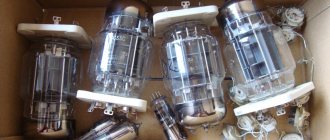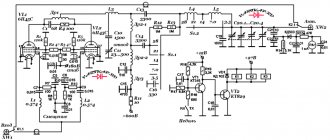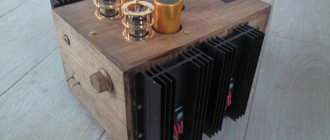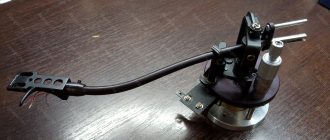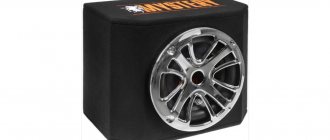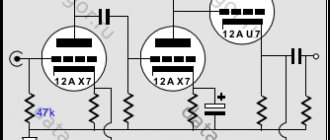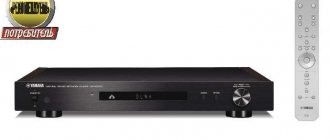Two-block amplifier using 2A3 tubes
Characteristics:
Output power 2 x 4.5 W (class A) Frequency range 15Hz - 24KHz (-1dB) Sensitivity 0.7 V Input impedance 100 kOhm
Output impedance 0.8 ohm
Signal-to-noise ratio 91 dB Power consumption 160 VA Radio tubes 2A3 x 2, 6S15P x 2, 5Ts4S x 3 Dimensions 440 x 350 x 175 mm Weight:
Amplifier 17 kg
Power supply 11 kg
Description:
The amplifier is assembled according to the “dual mono” principle.
The highest quality components were used during assembly,
Solder "MUNDORF MSolder SUPREME SilverGold" containing copper, silver and gold.
Wires are silver-plated with a 3-fold increased cross-section.
Two power transformers with 2.5x power reserve.
Interstage and output transformers have technical characteristics that exceed the world's best brands (this is a proven fact),
manufactured by a famous designer of Hi-End devices, inventor and author of many works on
radio electronics - Dmitry Aleksandrovich Andreev.
Possibility of adjusting the anode current of the output lamps using the indicator,
which is extremely necessary after replacing lamps and as a preventative measure.
Includes remote control (Volume and input selector for 4 sources)
Motorized volume control ALPS (Japan)
The amplifier housing is industrially produced, made at a Russian enterprise (Laser cutting and bending of metal) according to individual drawings.
Steel 1.5 mm, black paint-varnish.
The cost of the amplifier is 200,000 rubles.
I invite you to audition.
The Home Of Easy Tube Amplifier
(Article for the website audioportal.su, 2007)
I have long wanted to build and listen to an amplifier “only with triodes” in order to evaluate the so-called “pure triode sound” that is talked about so much on the forum. (***audioportal.su 2007)
Amplifier Circuit:
A little “idle” reasoning, including about this scheme:
For one reason or another, which can be discussed separately, I believe that a homemade amplifier should consist of as few amplification stages as possible, ideally 1. But, returning to the “real” world with real acoustics and taking into account the amount of labor involved , availability and cost of components, the required-optimal-possible number of amplification stages for me is still = 2.
Which connection between the cascades should you choose? Transformer, capacitive or direct (galvanic)?
Transformer coupling is optimal in terms of efficiency, but has several pitfalls -
- A good interstage transformer is quite large, its dimensions are quite comparable to the dimensions of the output transformer; As a result, the design turns out to be quite heavy;
- When the output stage supply voltage is, for example, 300 Volts and when the driver supply voltage is, for example, 200 Volts (which is typical for lamps suitable for operation on an interstage transformer), either two power supplies are required (one for the driver, the other for the output stage) or excess The voltage will have to be suppressed using a ballast resistor. Which leads to a seditious thought - wouldn’t it be easier to connect this resistor to the anode of the driver lamp, and remove the interstage transformer altogether?
- A transformer, even a very good one, still has uneven frequency and phase characteristics at the edges of the sound range, which adds a certain color to the sound.
Direct (galvanic) connection between cascades has both certain advantages and many disadvantages. The main advantage of such a connection is only one - the interstage capacitor is (at first glance) removed from the amplifier - one of the main sources of specific distortions and phase shifts.
Flaws -
- The implementation of such a connection according to the “Loftin and White Amplifier” topology has a number of technological disadvantages, such as a high supply voltage and a “large and hot” resistor in the cathode of the output tube - which, by the way, has a negative effect on the sound, reducing the dynamics of the amplifier.
- The option with two power supplies (“double-decker” power supply) is free from the above-mentioned disadvantage, but the signal current in this circuit also passes through two different capacitors of the power supply (through the “upper” and “lower” floors), which also contribute their color to the sound. It should be noted that it has been experimentally established that the effect of capacitors in the power supply on the sound is less noticeable than the effect of the interstage capacitor.
- To implement a “two-story” power supply, you need either two power transformers or a transformer with two windings (or taps from the windings), which also increases the weight of the structure.
- Setting up such an amplifier requires certain skills; the design requires periodic supervision and control and adjustment of modes.
- As a rule, in order to avoid loss of driver and output tube modes, the power supplies of such an amplifier must be stabilized, which also leads to design complexity.
Capacitive coupling between stages is a “classical” circuit design. The interstage capacitor, of course, affects the sound.
But, in my opinion and hearing, capacitors such as FT-2, FT-3, Wima MKP, Hovland, Auri, Cardas, Jensen PIO are almost neutral-transparent in the audio path. The use of capacitive coupling between stages in a two-stage SE amplifier, in my opinion, has undeniable advantages -
- Allows you to make the amplifier technologically simple - the stages can be configured separately, correction of the driver mode does not directly affect the mode of the output stage.
- The power supply of such an amplifier is “simple and light”.
- The tubes in such an amplifier operate safely - an unexpected failure of the driver tube does not lead to fatal consequences for the output stage.
- The signal path in such an amplifier is the shortest, which guarantees good sound quality and repeatable results.
- The power transformer for such an amplifier can be purchased ready-made, inexpensive and of very good quality, from classic manufacturers with an impeccable reputation - for example, such as Hammond.
Driver lamp selection.
Since the amplifier contains only two stages, the driver stage lamp must provide a gain of at least 30, the amplifier stage on it must be capable of delivering sufficient current to the load over the entire operating frequency range and, preferably, the grid bias voltage in operating mode should be no less than - 2 Volt.
Of the widely known and available triodes, these are 6S2P, 6S3P, 6S4P, 6S15P, 6S45P. During calculations, prototyping and listening, the choice was made on the 6S45P lamp.
The usually recommended mode for this lamp (-1.5 Volt bias, 150 Volts at the anode at a current of 30 mA) seemed not entirely suitable to me. The sound of this lamp in the following mode is very interesting - (-3.2 Volt bias, 220-225 Volts at the anode at a current of 20...25 mA) It should be noted that these lamps have a fairly wide spread, and I came across amazing specimens that had a gain of slightly more than 50, while the voltage at the anode was +205 Volts at an anode current of 25 mA.
In my amplifier, this lamp is operated at a slightly increased anode voltage, but since all other parameters are normal and the maximum power dissipation at the anode is lower than permissible, such inclusion is quite safe and does not have a significant impact on its service life.
I used a 3.2 Volt lithium battery as a source of grid bias voltage. The inclusion of a battery in the grid circuit made it possible to ground the cathode of the driver tube, thereby eliminating the influence of the cathode resistor and its shunt capacitor on the sound, and also “unambiguously” resolved the widely debated (*** in 2007 on audioportal.su) question about the required capacity of this capacitor.
I did not notice any negative impact of a high-quality battery on the sound. In this design, I used Duracell button batteries, soldering (observing all safety precautions!) leads to them from a single-core copper-silver wire in cotton-varnish insulation. Solder is regular store bought solder, with 2% silver. (***Later I began to use batteries with leads)
An adjustable integrated current source IXYS IXCP 10M45S was used as the anode load. Using this current source (an "ideal resistor") as an anode load is widely used in Western DIY designs, so I decided to try it too.
For the 6S45P lamp, this is practically the second (after a transformer or inductor) option for an ideal anode load, which makes it possible to obtain a high gain and excellent dynamic characteristics with a relatively low cascade supply voltage. In addition, the use of a current source can significantly increase the stability of the operating point (it is practically independent of changes in the supply voltage), which is very important when using a fixed bias.
The main characteristics of the driver stage at a power supply voltage of 300 Volts are as follows:
- Gain = 41…50 (depending on the lamp type)
- Nominal Input Voltage = 1V Rms (Maximum = 6.4V (P-to-P)
- Maximum undistorted output voltage with a load resistance of 150 kOhm = 135…140V (P-to-P), harmonic content in this case ~ 5%.
- Harmonic Distortion, at output voltage = 10 Volts Rms ~ 0.2% (Mainly second harmonic)
The cascade remains operational when the power supply voltage increases to 400 Volts, while the operating point remains stable, the harmonic distortion decreases, and the maximum output voltage increases. Thus, this stage can well be used as a driver for a lamp such as 300V.
Interstage capacitor.
The minimum required capacitance of the interstage capacitor can be determined by the well-known formula C = 159/FR (Microfarads, kilo-ohms, Hertz), where F is the lower limit frequency, R is the resistance of the grid leakage resistor of the output lamp, C is the capacitance of the interstage capacitor.
It should be remembered that the larger the capacitance of this capacitor, the lower the cutoff frequency of the filter formed by this capacitor and the grid resistor of the output lamp, and the smaller the phase shift introduced by this chain at a certain lower limit frequency and the wider the low frequency reproduction band. But the better quality the output transformer should be. In this circuit, the "safe-minimum" capacitance of this capacitor is 0.47uF. I used Auricap 1.5 uF.
The output stage does not have any circuit design features. The offset is fixed, from a separate source. Output tube 2A3 or 6C4C, transformer – Hammond 1628SEA, 5K->4 Ohm. Power supply voltage for the entire amplifier = 300 Volts, output stage lamp quiescent current = 60 mA, maximum (before visible limitation of the output signal) output power ~ 3.5 W.
Power unit.
I used a Hammond 372J as a power transformer. Its anode winding is designed for a current consumption of 250 mA, which is quite enough. A 5V 3A filament winding is used to power the filament of the kenotron, 6.3 V 3A is used to power the filament of the driver lamps.
The filaments of the output lamps are powered by a separate transformer. If you use 6C4C output lamps, their filament power will most likely have to be rectified and stabilized. I believe that powering the filament of the output lamps with a rectified, stabilized voltage does not have a negative effect on the sound. (*** Later I changed my point of view, especially for 6C4C lamps)
A 5Ts3S directly heated kenotron was used as a rectifier. To my ears, using “fast” semiconductor diodes as rectifiers makes the amplifier sound denser, sometimes even too dense - that’s why I still use kenotrons in my designs.
The use of classic chokes as filter elements in power supply, in my opinion, is no longer justified at present.
The amplifier supply voltage is stabilized. Even the simplest series parametric stabilizer makes it possible to obtain several tens of times lower output impedance and ripple level of the power supply, with significantly smaller weight and size parameters. In addition, with a stabilized supply voltage, better matching of lamp modes is ensured, and setting up the amplifier is much easier.
The bias voltage rectifier of the output lamps is assembled according to a circuit for doubling the rectified voltage with its subsequent filtering. This scheme does not have any special features.
What happened in the end - see below.
About the sound of this amplifier - it is “panoramic”, emotional, dynamic, dense and free at the same time. Collect and listen , you won't regret it.
May-June 2007 Vladivostok
*** The design turned out to be really very successful. This amplifier has been assembled by me many times for friends and acquaintances, and has also been repeated by many audio DIYers.
ULF circuit on class A HI-FI lamps (2A3 lamps)
Is there something wrong? Please disable Adblock.
The QRZ.RU portal exists only through advertising, so we would be grateful to you if you add the site to the list of exceptions. We try to place only relevant advertising that will be of interest not only to advertisers, but also to our readers. By disabling Adblock, you will help not only us, but also yourself. Thank you.
How to add our site to AdBlock exceptions
The above circuit operates with input signals with a level less than 0.5 V; if the signal level is higher, distortion appears. In the input stage, the signal voltage is amplified by approximately 7 times, and in the second amplification stage, the voltage increases another 10 times. Both stages use 56 type triodes (VI and V2). The output stage uses a V3 type 2AZ radio tube. To supply a 45V bias voltage to the V3 lamp grid, two 22.5V batteries are used in series (B1). In this circuit (as in other class A amplifiers), a direct current flows through the primary winding of the output transformer T1. To eliminate this, a modification was made to the circuit shown in Fig. 8.16. This change allows you to remove the DC component in the primary winding current, although at the cost of some power loss. The amplifier assembled using a modified circuit has a flat amplitude-frequency response (unevenness of no more than 1 dB) in the band from 20 Hz to 20,000 Hz.
(The modified circuit requires that a high-voltage transformer be used in the power circuit.) It should be noted that transformer T1 has only half of the primary winding connected, for which the middle terminal is used. This is done because the transformer used must have a primary impedance of approximately 8000 ohms. The recommended load resistance for a 2AZ (V3) lamp to obtain maximum output power is 2500 ohms, but increasing the load resistance reduces distortion at the cost of only a small reduction in output power.
Analogues of foreign parts can be found in the section
Class D mini amplifier on TPA3116 with Bluetooth 5, USB and Aux for pennies!
I absolutely welcome you!
Today I’ll talk a little about the Chinese class D mini-amplifier based on the rather successful TPA3116 chip. Reviewing music devices is a thankless task, but I'll try. Class D amplifiers were almost immediately given the offensive label “digital amplifier”; in fact, it would be more correct to call it a pulse amplifier. The operation is based on the principle of Pulse Width Modulation (PWM). The main advantage of class D amplifiers is energy efficiency (90% or more) and a large increase in efficiency.
For example, to obtain a power of 100-150 W at the output of a class AB amplifier, the amplifier must have a radiator that occupies one or two walls of the case, while a class D amplifier will make do with an aluminum radiator the size of a box of matches. The size of the board is also reduced several times, and, as a result, the cost of the device is lower.
However, Class D amplifiers also have weaknesses that have prevented them from completely taking over the HIFI segment. The presence of a high-frequency generator in a microcircuit can cause electromagnetic interference, which negatively affects the sound of the device. The high efficiency of class D amplifiers has also caused the sound quality to depend on the quality of the power supply. If the switching power supply does not have a sufficient number of filters, some of the noise will definitely penetrate the speakers and ruin the entire positive impression of the sound.
Mini Amplifier with bluetooth 5.0 AUX and USB on TPA3116 $17.99 WITH COUPON "BGFCTPA"
alternative amplifier models on TPA3116
excellway power supply 9-24V
Purpose of TPA3116 chips:
- Soundbars
- TVs
- Consumer audio
Characteristics:
- Bluetooth 5.0
- OTG function
- Hi-Fi sound
- noise suppression system
- bluetooth: 5.0, distance up to 12m
- Inputs: 3.5mm AUX, bluetooth, USB,
- RCA, TF memory card
- Outputs: Banana Speaker Jacks
- Amplifier chip: TPA3116
- Power: 100W, 50Wx2 Max (24V/4Ω)
- Speaker impedance: 4Ω-16Ω
- Frequency range: 20Hz-20KHz(±1dB)
- SNR: ≥98dB
- Power: DC9V-24V
- Dimensions: 110x90x50mm
- Weight: 160g
Completeness:
- Amplifier
- Instructions
That's the theory. What can you expect from a small Chinese box for $15-20?
Many may say that this is not class D, this is class G. Modern class D amplifiers produce sound no worse than class AB, but in this case we have a “well, just like that” microcircuit that produces, if not audiophile, then at least HiFi sound. Or, as one skeptic said, “For a Chinese box for $20, staggering speakers from a music center in a garage, student dorm, country house or workshop will be just the thing, cheap and cheerful.
To listen to music with normal acoustics in a prepared room - that’s it.”
So, I conducted the test on the speakers of the Sony RX99 music system (this is one of the top models from Sony in the late 90s and early 2000s). Perhaps it is not entirely correct to compare devices from different price segments, but everything is learned by comparison, and I know the sound from the RX99 very well.
For the purity of the experiment, the upper additional surround speakers were turned off, the compositions were played through the Poweramp player (the equalizers in the player and the Sony RX99 were set to zero).
I didn’t play Flac, the difference in sound is audible even for regular Mp3 compositions (who “has ears,” of course).
When turned on, the amplifier makes a clicking sound to the speakers.
The first thing that surprised me about the amplifier was the absence of extraneous interference in the speakers when using two power supplies. The first is 12V 3A (ordinary Chinese “consumer goods”, which I once bought for an LED strip). The second is a specially purchased one with a voltage switch from 9 to 24V and 3A (by the way, a very convenient device).
Both units powered the amplifier and 100-watt speakers from Sony. The only thing is that for such an amplifier I recommend taking power supplies with a current of 5-6 A (there will be less distortion at the output at high volumes).
You can comfortably listen to the speakers at a volume of 10-15 notches - this is enough for sound in a normal room of about 15-20 square meters (the maximum volume value is 30).
When the volume is increased to more than 20, sound distortion is heard and the speakers simply begin to what is called “screaming.” With a 12-volt power supply, the sound is muddier at high volumes compared to 24 volts.
Users can listen to the sound comparison for themselves in my video review at the bottom of this article.
According to my feelings, the low frequencies are clipped, and there is also a rollover in the high frequencies.
The sound of the Sony RX99 is clearly not up to par in terms of softness and panorama of the sound - the bass is flatter, “cardboard” or something, when the volume increases it becomes more “wooden” and hits the ears roughly (don’t expect softness).
High frequencies are also overwhelmed; not only are there fewer of them in principle compared to the sound from Sony, but there is also a certain harshness and dirtiness in the sound.
At the same time, there is detail in the sound, there is no “mess”, everything is clearly spelled out, wind instruments and classical instruments in general sound good.
In some ways, the sound reminded me of the sound of boomboxes - loud, ringing, clear, but as for me, the bass is cut and there are not enough highs.
A tone block in this box would obviously not be amiss; it would be possible to “tighten up” the missing frequencies a little.
In general, the box is worth its price, it’s super compact, lightweight, you can easily take it anywhere and connect any speakers.
But, naturally, this is not a completely audiophile device, but rather a portable option for field conditions.
Flash drives are read in FAT32 format (NTFS is not seen), and, naturally, like most Chinese devices that read USB, the drawback remains the same - the lack of a mode for shuffling songs during playback.
Bluetooth connects without problems.
The insides, for those interested, are under the spoiler:
Click to expand
Video review
https://youtu.be/l8oa5nCxgiw
conclusions
Class D amplifiers are a good alternative to budget HI-FI. With a small budget, we get acceptable parameters, as they say, “good and inexpensive.” If power consumption is not satisfactory, then sound is still a matter of debate. Class D in its pure form gives the highest quality, but neutral, as if “uncolored” sound. Not everyone will like this sound, and specifically it is unlikely to please users who are accustomed to listening to retro tube equipment. It is possible that audiophiles and people with “ears” will say that such things only belong in the trash. In general, if the manufacturer has not saved on the key elements of the microcircuit, the amplifier is as close to perfection as possible. Everything else is a matter of taste.
This particular amplifier produces standard household sound, not devoid of instrument detail, which can even be called quite good and it is quite possible to listen to the same mp3s or audio files from your phone.
The undoubted advantage is its versatility (you can connect anything to it), compactness and portability. If you are a person with “ears” and hear the difference between mp3 and Flac sound, then, naturally, you will need a “more serious” device. For everything is known by comparison.
Well, that's all, friends, thank you for your attention and happy online shopping everyone!
Sergei Klimanski
After reading the headline, the reader will not believe it - a 2A3 lamp cannot provide such power. And he will be right if we talk about the classic 2A3. But the fact is that the new production has launched the production of lamps in large cylinders, which allows you to dissipate not 16 watts on the anode without any problems (like the classic 2A3), but much more. I tested a circuit with 2A3-40 JJ or 2A3 Full Music (later Sovtek and ElectroHarmonix were also tested), where the output lamp has an anode current of 75 - 90 mA with an anode voltage of about 340 Volts.
The current through 6E5P is 25 - 30 mA at an anode voltage of 170 Volts.
The anode choke is Chinese, purchased on e-Wow, its active resistance is about 2.3 KOhm, which at a current of 25 - 30 mA gives the voltage drop necessary for a 2A3 bias.
The battery for creating bias on 6E5P is a CR2032 battery. The mains transformer is American from Magnetic Components Inc., part N 40-18029 ( https://www.magneticcomponents.net/ ), it was originally black and I painted it with automotive spray paint, like the tea cans that served as the screen and a housing for anode chokes. As it turned out later, this transformer has only 50 watts of power (but looks like 100 watts) and therefore the EZ80 filament power supply and the anode power supply for powering the negative voltage source (2x330 V) had to be made in the form of a remote power supply unit, which consists of only one ANTEK AN05 transformer -T320. To power the 2A3 and 5U4G filaments, two 20 Watt toroidal transformers were made (the secondary of the filament transformers for halogen lamps was rewound) with an electrostatic shield to prevent network and other interference from entering the filament; each transformer had two secondary windings of 2.5 Volts each. Initially, the first stage on the 12AU7 was omitted and the input signal was fed directly to the primary winding of the Tr3 transformer (TZL6F interstage from Audioinstrument). The circuit produces 6 watts of undistorted output power with a sensitivity of about 2 volts. Listening was carried out in combination with an open screen and a Visaton B200 full-range speaker. When turned on for the first time, the amplifier began to play only after 3 - 4 hours of warming up. The 6E5P turned out to be a very good lamp - in terms of tonal balance and detail of the images, I would give it an 8 (out of 10), and in terms of stage volume a 6. Due to the special pinout of the 6E5P, no other lamps have been tested yet, but now I am making an adapter for 6P15P, 6E6P , 12V4A and other lamps. Regarding the weekend 2A3. A comparison was made between 2A3 JJ and Full Music. For my taste, the Chinese tube outperformed the JJ in both the detail of the mid and high frequencies and the volume of the stage. The only thing I liked about JJ was the bass. Full Music, despite the nameplate maximum 16 watts, it confidently holds 27 watts without the occurrence of anode current drift.
The sound only benefited from this. In general, the amplifier impressed with its deep, “weighty” bass, unusual for a single-ended amplifier, apparently due to the high quality of the output transformer and the absence of interstage capacitors. Well, as expected, 2A3 - excellent detail in the middle. All this together left a very pleasant listening experience. And I note once again that for the 6E5P, working in combination with the 2A3 was a very serious test, which, in my opinion (more precisely, in my ear), it passed with dignity. Now about the noticeable shortcomings - I would note a somewhat “down-to-earth”, transistor sound of frequencies in the range of about 10 kHz, the “plate” seems to lack air and sharpness. Well, it should be noted, although barely noticeable, but still there is a somewhat dry, analytical sound of the 2A3 in comparison with the pentode in the output stage - my previous project on the 6P7S in ultra-linear switching sounds somewhat livelier, “richer”, musical images are drawn somewhat brighter . The difference is almost unnoticeable in loud pop music, but becomes noticeable in classical music - plucked and wind instruments performed by triodes seem to fade into the background.
Technical data - reproduced frequency range - at a level of minus 3 dB from 5 Hz to 84 kHz, at a level of minus 1 dB - from 8 Hz to 52 kHz.
Added on April 2, 2011: the above-mentioned “transistor” sound at high frequencies disappeared along with the replacement of the odious Emission Labs kenotron with the usual 5Ts3S. Once again I was convinced of the very good sound signature of this kenotron, at least it is a champion in terms of price/quality ratio.
I want to explain why I put the battery in the lamp grid and not in the cathode? The whole point is that while in the cathode, the battery is placed in charging mode, while all the current flowing through the lamp flows through it. It is well known that a charging battery connected to a current source represents a nonlinear resistance in an equivalent circuit, the value of which depends on the applied voltage. That is, it turns out that by replacing a resistor + capacitor with a battery in the classical bias supply circuit, we essentially simply replace a linear resistor with a nonlinear one (with all the ensuing consequences) and a classical capacitor with a battery, which is essentially the same capacitor, only with a very large capacity – but it only has a large capacity in static mode! For alternating current, everything will be different here and with increasing frequency, the resistance will increase and the capacitance will decrease - that is, we will have all the delights of the problems of TWO nonlinear elements connected in parallel - a nonlinear resistor + a nonlinear capacitor. Purely theoretically, the only benefit here can be the noticeably lower parasitic inductance of the battery compared to capacitors. When the battery is connected to the grid circuit - due to two to three orders of magnitude lower current through the battery and the very high input resistance of the lamp - the mentioned shortcomings of the battery will have a noticeably less impact. All that remains is to protect the lamp input circuits from interference and reduce the parasitic installation capacitance, which is easily achieved by proper arrangement of the elements. And one last thing. If the amplifier operates for a long time, the battery of small size and power will always be overcharged, which will inevitably lead to its premature failure (and if the charging current is exceeded, it may, unfortunately, explode).
I'm currently listening to 2A3 Sovtek. Dissipates 28 watts easily. Anode current 75 mA. I like her sound more than JJ and FullMusic. And the main difference is that the sound is more voluminous and lighter. FullMusic is somewhat inferior in the processing of mid frequencies, but the difference is barely noticeable.
Another observation is that the new 6E5P take quite a lot of time to “break in” - they only begin to sound after about 10 hours, and this despite the fact that I deliberately adjusted the filament voltage in the amplifier to a maximum of 7 Volts. I used NOS (New Old Stock) Saratov plant, 1979. Some lamps, when first turned on, had a strong blue glow inside the anode, but after 10–20 minutes it fades away and the lamp works as usual.
Updated April 6. The scheme has been slightly modified. To reduce the background and improve dynamics, in addition to the existing capacitors in the power supply, MBGO 10 µF 300 V capacitors were added to the 6E5P power supply branch and K73-P2 6 µF 400 V capacitors were added to the 2A3 anode supply. When listening, this was reflected not only in improved dynamics, but also led to an increase in the detail of the midrange and high frequencies. A switch has also been added to switch the impedance of the output transformer 2.5/3.5 K. Modified circuit:
Updated on April 17, 2011: I received golden boxes from 2A3 Electroharmonics (EH). The listening confirmed the opinion known from the Audio Portal - this is probably the best version of 2A3 that I have listened to. I would arrange these 2A3s in a row like this - EH, Sovtek, Full Music, JJ. Yes, yes, this is not a mistake - unfortunately, here too the most expensive lamp turned out to be not the best in sound. Not all that glitters is gold!
OPPO HA-2SE Portable Headphone Amplifier
HIGH PERFORMANCE AUDIO
- Hybrid Class AB Amplifier The HA-2SE's headphone power amplification circuit is a Class AB amplifier consisting of integrated circuits (ICs) and discrete transistors.
The discrete transistor output stage uses carefully selected and matched parts. The output transistors are biased to operate in the most linear range of critical small signals and reach their full potential when power is required. - Clear Signal Path The HA-2SE does not have a DSP (Digital Signal Processor). The volume control is controlled by a combination of the DAC chip's internal digital volume control and an analog potentiometer (the familiar volume knob). Bass enhancement is carried out by pure analog audio circuitry. By avoiding re-digitizing the audio signal to adjust volume or boost bass, the HA-2SE provides a clean signal path for audio.
- Audio Input and Line Out The HA-2SE has a 3.5mm audio input port to support portable music players that do not have a USB-compatible digital output. While the HA-2SE is used with one of the USB digital input ports, the 3.5mm jack acts as a line output for the USB DAC.
- ESS Saber 32 Reference DAC DAC is one of the most important components for digital audio reproduction. The ES9028-Q2M DAC chip used in the HA-2SE is the latest flagship mobile DAC developed by ESS Technology. Featuring ESS's patented 32-bit Hyperstream™ DAC architecture and time-domain jitter eliminater, the SABRE32 reference DAC delivers unprecedented performance for mobile applications.
- Hi-Fi sound matches the style
- Asynchronous USB DAC Bypassing the smartphone's built-in DAC and headphone amplifier circuitry, which are often cost-constrained, the HA-2SE turns your smartphone into a high-performance digital audio player. The HA-2SE's asynchronous USB DAC input also works with PCs and Macs, replacing the built-in sound card and supporting high-resolution audio playback with PCM up to 384 kHz 32-bit and DSD up to 12 MHz (DSD256).
- Bass Boost For those who love more powerful and impressive music, the HA-2SE offers a Bass Boost feature.
With bass boost turned off, the HA-2SE provides a flat frequency response; With bass boost turned on, the HA-2SE adds power and impact to the sub-bass region without confusing the important mid- and high-frequency bands. - Two Gain Settings The HA-2SE offers two gain levels for optimal matching with headphones. High Gain mode can drive large, power-hungry headphones with up to 300mW of power into 16-ohm headphones. Low gain mode is designed for sensitive In-Ear Monitor headphones.
PREMIUM MOBILITY
- Made for iPod®, iPhone® and iPad®, the HA-2SE is Apple "MFi" certified and compatible with the latest iPods, iPhones and iPads, which can be used as accessories for the digital audio output of these devices. Featuring a direct connection to the digital audio signal of these devices devices and converting audio to analog using the high-performance SABER 32 Reference DAC, music from your favorite portable device will sound its best.
Additionally, for users of high-resolution music applications, the HA-2SE does not require the use of a Camera Connection Kit (CCK). The data cables that came with your Apple device or the included Lightning cable are sufficient.
- Android Compatibility The HA-2SE's micro-USB input port works with Android devices that support USB OTG (USB On-The-Go) and USB Audio Class. The HA-2SE comes with a dedicated USB OTG cable for easy connection. When used with a compatible Android device, the HA-2SE can support the device's built-in music app, ringtones and notifications. Additionally, a high-resolution music playback application can use the HA-2SE as an external DAC to play lossless PCM and DSD audio files.
- Mobile Power Bank HA-2SE works as an external battery to charge your mobile device. Functionality and convenience are the factors we wanted to address with the HA-2SE, so you can skip the bulky spare battery and carry just the HA-2SE.
- Fast Charging HA-2SE is equipped with OPPO's patented VOOC fast charging technology. Using the included fast charger, the internal battery can be quickly and safely charged to 70% capacity in about 30 minutes. Fully charging the battery takes approximately 90 minutes. Fast charging gives the HA-2SE hours of use.
- Build Quality The HA-2SE is housed in an aluminum body covered in genuine leather. The beveled metal edges and contrasting stitching on the leather are eye-catching. Its cut and finish will make you feel proud to use the product. The HA-2SE fits equally well in the pocket of an urban millennial or on the desk of a business executive.
SPECIFICATIONS
Design and specifications are subject to change without notice.
| Are common | |
| Dimensions (W x H x D) | 2.7 x 5.375 x 0.5 inches, 68 x 137 x 12 mm |
| Weight | 6.
|
| Frequency response | 20 Hz - 200 kHz |
| Audio input level | 1 V rms |
| Line output | 1 V rms |
| Recommended headphone impedance | 16 Ohm - 300 Ohm |
| Maximum headphone output power (per channel) | 300 mW into 16 Ohms 220 mW into 32 Ohms 30 mW into 300 Ohms load |
| Headphone amplifier output impedance | 0.5 Ohm |
| Output jacks | Stereo headphones 3.5 mm Stereo line out 3.5 mm |
| Input ports | Analogue: 3.5mm stereo audio input Digital: USB A for iPod/iPhone/iPad; USB micro-B for smartphones with USB OTG function and computers. |
| DAC chip | ESS Saber 32 Link ES9028-Q2M |
| Input format | Stereo PCM, Stereo DSD (DoP v1.1 or native) |
| PCM sampling rates | 44.1 kHz - 384 kHz, 16/24/32 bit |
| DSD sampling rates | 2.8224 MHz (DSD64), 5.6448 MHz (DSD128), 11.2896 MHz (DSD256, native mode only) |
| Profile | USB 2.0, USB Audio 2.0 |
| Accessories included | Power Supply (Fast Charging Charger) USB A to USB micro-B data cable and fast charging USB A to Lightning data cable (for Apple devices) USB micro-B micro-B data cable (for Android and other smartphones) 3.
|
| Battery | |
| Built-in battery type | Lithium polymer battery 3000 mAh |
| Battery life | Approx. 13 hours for analog source via audio input; approx. 7 hours for digital sources via USB |
| Charging time | Approx. 1 hour 30 minutes |
“Made for iPod,” “Made for iPhone,” and “Made for iPad” means that an electronic accessory has been designed specifically to connect to an iPod®, iPhone®, or iPad®, respectively, and has been certified by the designer to meet Apple performance standards. Apple is not responsible for the operation of this device or its compliance with safety and regulatory standards. Please note that using this accessory with an iPod, iPhone or iPad may affect wireless network performance.
iPad, iPhone, iPod and iPod touch® are trademarks of Apple Inc., registered in the US and other countries.
Compatible Models iPod/iPhone/iPad USB works with iPhone 7, iPhone 7 Plus, iPhone 6S, iPhone 6S Plus, iPhone 6, iPhone 6 Plus, iPhone 5S, iPhone 5C, iPhone 5, iPhone 4S, iPad (4th generation) , iPad mini, iPod touch (5th generation). ).
The HA-2SE's USB B input works with Android devices that support USB OTG (USB On-The-Go) and USB Audio Class 2.0. Not all devices are compatible. An optional USB Type C to Micro USB cable is required for use with USB Type C devices.
Android is a trademark of Google Inc.
All trademarks are the property of their respective owners.
